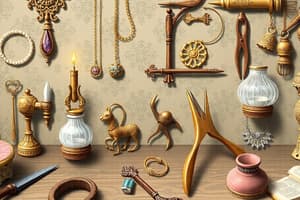Podcast
Questions and Answers
What is one benefit of plating chains with various finishes?
What is one benefit of plating chains with various finishes?
- It changes the metal type of the chain.
- It enhances the beauty and durability while reducing corrosion. (correct)
- It makes the links unsoldered.
- It makes the chain heavier.
Which metal is particularly noted for being lightweight and colorful?
Which metal is particularly noted for being lightweight and colorful?
- Steel
- Aluminum (correct)
- Brass
- Copper
What is the purpose of soldering chain links?
What is the purpose of soldering chain links?
- To imprint textures onto the chain surface.
- To make the chain less flexible.
- To elongate the shape of the links.
- To close and secure links to prevent stretching and breakage. (correct)
When links of a chain are unsoldered, what must they be capable of?
When links of a chain are unsoldered, what must they be capable of?
What does the flattening process do to wire links?
What does the flattening process do to wire links?
Which technique improves the reflectivity of metal chain links?
Which technique improves the reflectivity of metal chain links?
What does the dapping process create on metal links?
What does the dapping process create on metal links?
Which of the following materials is commonly used for making durable chains?
Which of the following materials is commonly used for making durable chains?
What is the primary purpose of split rings?
What is the primary purpose of split rings?
Which type of pliers is primarily used for crimping?
Which type of pliers is primarily used for crimping?
What feature distinguishes magical crimping pliers from regular crimping pliers?
What feature distinguishes magical crimping pliers from regular crimping pliers?
What type of cutter is specifically designed for cutting memory wire?
What type of cutter is specifically designed for cutting memory wire?
Which of the following is NOT a basic tool mentioned for jewelry making?
Which of the following is NOT a basic tool mentioned for jewelry making?
What makes spring-loaded tools easier to use?
What makes spring-loaded tools easier to use?
Which tool is used for creating a hammered look on wire?
Which tool is used for creating a hammered look on wire?
What is a primary function of round nose pliers in jewelry making?
What is a primary function of round nose pliers in jewelry making?
What is the primary use of a bench block in wireworking?
What is the primary use of a bench block in wireworking?
Which tool is best suited for larger gripping surfaces?
Which tool is best suited for larger gripping surfaces?
Which aspect of side cutters allows for close cuts on small projects?
Which aspect of side cutters allows for close cuts on small projects?
What is the main design feature of chain nose pliers?
What is the main design feature of chain nose pliers?
What is the main function of a wire jig?
What is the main function of a wire jig?
Which material is typically used for the head of a mallet?
Which material is typically used for the head of a mallet?
Why are measuring tools vital in wireworking?
Why are measuring tools vital in wireworking?
What is the purpose of the rounded head on a ball-peen hammer?
What is the purpose of the rounded head on a ball-peen hammer?
What is the first step in applying super glue to memory wire jewelry?
What is the first step in applying super glue to memory wire jewelry?
What tool is specifically recommended for cutting memory wire?
What tool is specifically recommended for cutting memory wire?
What is the first step when creating a hoop from wire?
What is the first step when creating a hoop from wire?
How should jump rings be properly opened?
How should jump rings be properly opened?
What should the ends of the wire overlap by when preparing to make a closure in hoop making?
What should the ends of the wire overlap by when preparing to make a closure in hoop making?
Which technique is essential for completing multistrand necklaces?
Which technique is essential for completing multistrand necklaces?
What is the advantage of using split ring pliers?
What is the advantage of using split ring pliers?
What material is memory wire primarily made of?
What material is memory wire primarily made of?
What must you avoid doing when opening a jump ring?
What must you avoid doing when opening a jump ring?
When embellishing hoop earrings, what should be done before bending the end to make the hook?
When embellishing hoop earrings, what should be done before bending the end to make the hook?
Which of the following is not a step when using split ring pliers?
Which of the following is not a step when using split ring pliers?
What should be used instead of crimp beads when working with nylon or silk for attaching strands to loops?
What should be used instead of crimp beads when working with nylon or silk for attaching strands to loops?
What is a key feature of split rings compared to jump rings?
What is a key feature of split rings compared to jump rings?
What embellishment can be added to the loop ends of memory wire jewelry?
What embellishment can be added to the loop ends of memory wire jewelry?
What is the purpose of stringing a cone onto the wire after crimping the strands?
What is the purpose of stringing a cone onto the wire after crimping the strands?
Which of these statements correctly describes memory wire?
Which of these statements correctly describes memory wire?
What is the primary reason pure gold is mixed with other metals when making jewelry?
What is the primary reason pure gold is mixed with other metals when making jewelry?
What does the term 'karat' refer to in gold alloys?
What does the term 'karat' refer to in gold alloys?
Which process results in a thicker gold layer than gold-plating?
Which process results in a thicker gold layer than gold-plating?
What is the typical alloy composition of rose gold?
What is the typical alloy composition of rose gold?
How does white gold generally achieve its tarnish resistance?
How does white gold generally achieve its tarnish resistance?
What is a notable characteristic of silver when exposed to air over time?
What is a notable characteristic of silver when exposed to air over time?
Which statement about vermeil is true?
Which statement about vermeil is true?
What is the typical result of combining gold with zinc, nickel, or silver?
What is the typical result of combining gold with zinc, nickel, or silver?
Flashcards
Chain Materials
Chain Materials
Chains can be made from various materials, including gold, silver, brass, copper, steel, and aluminum.
Plating Process
Plating Process
Applying a thin layer of another metal to a metal chain to enhance appearance, improve durability, and reduce corrosion.
Soldered vs. Unsoldered Chain
Soldered vs. Unsoldered Chain
Soldered chains have connected links, preventing stretching and breakage, while unsoldered chains have separate links suitable for decoration.
Flattening Chain
Flattening Chain
Signup and view all the flashcards
Drawing Chain
Drawing Chain
Signup and view all the flashcards
Dapping Chain
Dapping Chain
Signup and view all the flashcards
Hammering Chain
Hammering Chain
Signup and view all the flashcards
Texturing Chain
Texturing Chain
Signup and view all the flashcards
Soldered rings
Soldered rings
Signup and view all the flashcards
Split rings
Split rings
Signup and view all the flashcards
Split ring pliers
Split ring pliers
Signup and view all the flashcards
Round nose pliers
Round nose pliers
Signup and view all the flashcards
Chain nose pliers
Chain nose pliers
Signup and view all the flashcards
Crimping pliers
Crimping pliers
Signup and view all the flashcards
Coiling pliers
Coiling pliers
Signup and view all the flashcards
Flat nose pliers
Flat nose pliers
Signup and view all the flashcards
What's the purpose of flexible beading wire cutters?
What's the purpose of flexible beading wire cutters?
Signup and view all the flashcards
What tool is essential for cutting memory wire?
What tool is essential for cutting memory wire?
Signup and view all the flashcards
What is a side cutter used for?
What is a side cutter used for?
Signup and view all the flashcards
What is a ball-peen hammer used for?
What is a ball-peen hammer used for?
Signup and view all the flashcards
What does a chasing hammer do?
What does a chasing hammer do?
Signup and view all the flashcards
What is a mallet used for in wireworking?
What is a mallet used for in wireworking?
Signup and view all the flashcards
What is a bench block used for?
What is a bench block used for?
Signup and view all the flashcards
What is a wire jig used for?
What is a wire jig used for?
Signup and view all the flashcards
Memory wire jewelry
Memory wire jewelry
Signup and view all the flashcards
Memory wire cutters
Memory wire cutters
Signup and view all the flashcards
Jump rings
Jump rings
Signup and view all the flashcards
Opening jump rings
Opening jump rings
Signup and view all the flashcards
Closing jump rings
Closing jump rings
Signup and view all the flashcards
Using split ring pliers
Using split ring pliers
Signup and view all the flashcards
Hoop Earring Closure
Hoop Earring Closure
Signup and view all the flashcards
Wire Wrapped Loop
Wire Wrapped Loop
Signup and view all the flashcards
Crimp Bead
Crimp Bead
Signup and view all the flashcards
Cone in Jewelry Making
Cone in Jewelry Making
Signup and view all the flashcards
Memory Wire
Memory Wire
Signup and view all the flashcards
Memory Wire Finishing Method 1
Memory Wire Finishing Method 1
Signup and view all the flashcards
Bead Tip
Bead Tip
Signup and view all the flashcards
Cones for Multistrand Necklaces
Cones for Multistrand Necklaces
Signup and view all the flashcards
Karat Gold
Karat Gold
Signup and view all the flashcards
Gold-filled
Gold-filled
Signup and view all the flashcards
Gold-plated
Gold-plated
Signup and view all the flashcards
Vermeil
Vermeil
Signup and view all the flashcards
White Gold
White Gold
Signup and view all the flashcards
Rose Gold
Rose Gold
Signup and view all the flashcards
Sterling Silver
Sterling Silver
Signup and view all the flashcards
What is the purpose of mixing metals in jewelry?
What is the purpose of mixing metals in jewelry?
Signup and view all the flashcards
Study Notes
Beaded Jewelry - Wirework Techniques
- This book details skills, tools, and materials for making handcrafted jewelry.
- Authors are Carson Eddy, Rachael Evans, and Kate Feld.
- The book covers a range of topics from wire types to chain basics, findings, tools, techniques, and metal types.
- Metal is the fundamental material in jewelry making. Humans have used metals since the beginning of civilization.
- Different metals have different qualities and are combined to make alloys.
- Alloys are used for jewelry-making due to specific qualities like malleability, conductivity, and strength.
- Various metals are used in jewelry, including gold; specific standards and terminology for gold content in alloys (karat).
- Lead is a metal used traditionally in alloys but is now being regulated in some areas due to health concerns.
- Other metals mentioned include copper, brass, sterling silver, fine silver, and Argentium.
- There are different types of wire, such as flexible beading wire, hard wire, and others; with different diameters and colors.
- Wire is a versatile material for jewelry and craft projects.
- Different types of pliers and cutters are essential for various wirework tasks.
- Different types of shaping tools and techniques.
- Techniques for making simple loops, wire-wrapped loops, wire-wrapped bead caps, and chain-wrapped links/chains.
- Information on various types of chains, and their characteristics.
- Information on finding styles, like clasps, earring Findings, and other decorative elements.
- Information on tools to work with, like wire shaping tools, coil pliers, crimp pliers, flat-nose pliers & round-nose pliers.
- Different types of storage containers for storing jewelry parts.
- Methods for embellishing jewelry with elements like beads.
- A guide for working with memory wire.
- Instructions on how to open and close jump rings, and how to use split ring pliers.
- Information on how to use wire cutters.
- A glossary of terms, including definitions of metals like alloy, annealing, anodization, base metal, corrosion, draw plate, ductility, fusing, gauge, hypoallergenic, karat, luster, malleability, ounce, pennyweight, plating, and tarnish.
- Other resources, such as related Storey Basics titles, are listed in the book.
Studying That Suits You
Use AI to generate personalized quizzes and flashcards to suit your learning preferences.




